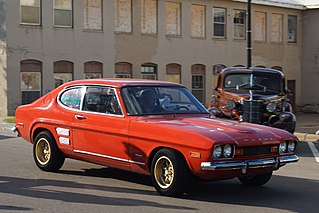
The Ford Capri is a fastback coupé built by Ford of Europe and designed by Philip T. Clark, who had been involved in the design of the Ford Mustang. It used the mechanical components from the Mk2 Ford Cortina and was intended as the European equivalent of the Ford Mustang. The Capri went on to be highly successful for Ford, selling nearly 1.9 million units in its lifetime. A wide variety of engines were used in the car throughout its production lifespan, which included the Essex and Cologne V6 at the top of the range, while the Kent straight-four and Taunus V4 engines were used in lower-specification models. Although the Capri was not officially replaced, the second-generation Probe was effectively its replacement after the later car's introduction to the European market in 1994.

The Essex V4 is a V4 petrol engine manufactured by the Ford Motor Company from 1965 to 1977. The engine was available in both 1.7 L and 2.0 L capacities. Designed by Ford of Britain, the Essex V4 was produced at a plant in Dagenham, originally in the county of Essex, later part of east London. The engine was used in the Ford Corsair, Capri Mk I, Consul/Granada Mk I, Ford Zephyr Mk IV and the Ford Transit Mk I van.
The name Ford Corsair was used both for a car produced by Ford of Britain between 1963 and 1970, and for an unrelated Nissan-based automobile marketed by Ford Australia between 1989 and 1992.
Wilhelm Karmann GmbH, commonly known as Karmann, was a German automobile manufacturer and contract manufacturer based in Osnabrück, Germany. Founded by Wilhelm Karmann in 1901, the company specialised in various automotive roles, including design, production and assembly of components for a wide variety of automobile manufacturers, including Chrysler, Porsche, Mercedes-Benz and Volkswagen Group.

The Ford Consul is a car that was manufactured by Ford of Britain from 1951 until 1962. The name was later revived for a model produced by Ford in both the UK and in Germany from 1972 until 1975.

Capri is a nameplate marketed by the Lincoln-Mercury division of Ford Motor Company over three generations between 1970 and 1994.

The Geneva International Motor Show was an annual auto show held in March in the Swiss city of Geneva.

The International Motor Show Germany or International Mobility Show Germany, in German known as the Internationale Automobil-Ausstellung, is one of the world's largest mobility trade fairs. It consists of two separate fairs, that subdivided in 1991. While the IAA Mobility displays passenger vehicles, motorcycles and bikes, the IAA Transportation specializes in commercial vehicles. Before the separation, the show was held solely at the Messe Frankfurt.

The Ford Escort is a small family car that was manufactured by Ford of Europe from 1968 until 2000. In total there were six generations, spread across three basic platforms: the original, rear-wheel-drive Mk.1/Mk.2 (1968–1980), the "Erika" front-wheel-drive Mk.3/Mk.4 (1980–1992), and the final CE-14 Mk.5/Mk.6 (1990–2002) version. Its successor, the Ford Focus, was released in 1998, but the final generation of Escort was phased out gradually, with the panel van version ending production in 2002 in favour of the Ford Transit Connect.

The C-segment is the 3rd category of the European segments for passenger cars and is described as "medium cars". It is equivalent to the Euro NCAP "small family car" size class, and the compact car category in the United States.
1988 in motoring includes developments in the automotive industry throughout the year 1988 by various automobile manufacturers, grouped by country. The automotive industry designs, develops, manufactures, markets, and sells motor vehicles.
2000 in motoring deals with developments in the automotive industry that occurred throughout the year 2000 by various automobile manufacturers, grouped by country.

Ford of Europe GmbH is a subsidiary company of Ford Motor Company founded in 1967 in Cork, Ireland, with headquarters in Cologne, Germany.

The automotive industry in Germany, is one of the largest employers in the world, with a labor force of over 857,336 (2016) working in the industry.

The Rover R8 platform was an automobile platform used for the Mark I Rover 200 Series and the Mark II 200 and 400 Series, compact family cars produced by the Austin Rover Group, and later the Rover Group.

Karl Deutsch GmbH was a coach building firm known, in its later years, for converting mainstream motor cars into cabriolets. The business was located in Köln-Braunsfeld, a district on the west side of what today would be defined as central Cologne.
Middle East Motor Awards (MEMA) is an auto award in the Middle East, with a ‘Car of the Year' honor as well as individual category winners. The awards are given to newly released or redesigned vehicles released to the regional car market, annually since 2010. The awards are judged by a panel of distinguished and expert automotive journalists.

The Ford Fiesta Mk1 is the first generation of the Ford Fiesta supermini. It was introduced in 1976 as Ford Europe's first multi-national front-wheel-drive automobile, and was available in both 3-door hatchback and panel van derivatives. In 1983, the Fiesta was updated, and the Fiesta Mk2 was introduced.














